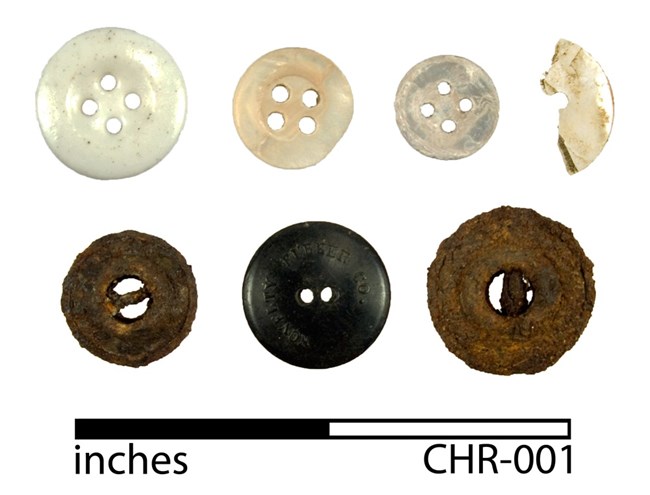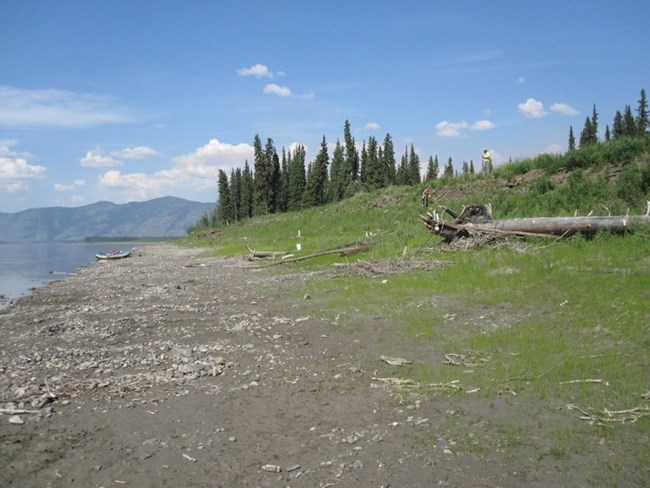Last updated: November 2, 2021
Article
Charley's Village
Yukon-Charley Rivers National Preserve is named for the two great rivers that are in many ways the focal points of the preserve. Upstream of the Charley River, the Kandik River, once called Charley Creek, flows into the Yukon. Near this confluence there was once an important village site, the historic home of Chief Charley and his Han Gwich'in Athabaskan followers.
According to the historic accounts of the Episcopal archdeacon Hudson Stuck, "phenomenally high water" resulting from spring breakup on the Yukon in 1914 washed away the last remnants of a small cluster of houses near the mouth of the Kandik River. The former occupants of these houses are said to have then scattered to other villages up and down the Yukon, but the place once known as Charley's Village was ultimately destroyed.

Charles Farciot
A small assemblage of artifacts is held in the Yukon-Charley Rivers National Preserve museum collections. Fortunately, Charley and the village that bears his name achieved a certain notoriety in the history of the Yukon-Charley region. The resulting historic accounts serve in a way to breath new life into what might otherwise be rather mundane archaeological finds. Such research provides us an opportunity to learn more about this particular segment of Han history.
This web exhibit explores the history of the site itself as well as the various efforts to identify, record, and interpret what was Charley's Village. The links below allow you to examine some of the artifacts and events associated with these efforts.
To discuss Charley's Village one must first acknowledge the village's namesake. Chief Charley was the leader of a group of Han Gwich'in Athabaskans living along the Yukon River sometime during the late 19th and early 20th centuries. The first known appearance of Charley in the written record is found in the 1871 journals of Robert McDonald, an Anglican Missionary. Robert and his brother Kenneth, also a missionary, document their various interactions with Charley and his people throughout the upper Yukon country until 1876.
In 1879 the persistant trader Leroy "Jack" McQuesten stopped at Charley's Village on his way upriver to attempt to reopen the defunct Hudson's Bay Company's Fort Reliance. McQuesten declined Charley's offers to set up a trading post at the village as he did not want to build a new store. The following summer explorer Ivan Petrov stopped at Charley's Village and noted the presence of 48 inhabitants. This is the first mention of the size of Charley's band.
The first description of the actual village comes from Lt. Frederick Schwatka, who in 1883 noted a village at the mouth of the Kandik River which was composed of 5 or 6 small houses and populated by approximately 50 people. Another account of the village comes from a prospector enroute to the Fortymile country in 1886. As Arthur Walden describes it, the village consisted of "three or four houses, built of tiny poles laid one on top of the other."
By the late 1880's a gold rush was in full swing and it seems that Charley and his band abandoned their village by the Kandik to relocate to the Fortymile country, perhaps to be closer to imported goods and the opportunity for increased trade. Apparently by 1900 Charley's Village was once again inhabited according to the accounts of Judge James Wickersham who briefly describes visiting Charley's Village in February of 1901.
A U.S. census taker in 1910 recorded the population of Charley's Village at 25 people. In June of the following year Hudson Stuck visited the village and counted 10 to 12 people. He counted only 7 the following April. Two years later during the spring breakup of 1914 Charley's Village finally met its end, swept away by flood waters.
Though many accounts noted the location of the village over the years, some of them were conflicting and as there were very few reliable maps created at the time which documented such features as Native villages, the precise location was to remain somewhat of a mystery for many years.
In 1974, during preliminary surveys conducted in order to assess the environment and culture history of the then proposed Yukon-Charley Rivers National Preserve, a crew led by Edwin Hall Jr. attempted to locate the village site but to no avail. Three years later, based on oral histories and various documented accounts, historian, Melody Webb visited what she believed to be the site of Charley's Village, but did not conduct a thorough survey or make any collections.
It was not until 1992 that any intensive effort was undertaken to assess if the site documented by Webb, might in fact be Charley's Village. That summer a crew of NPS archaeologists noted artifacts on the beach and eroding out of a cutbank near where Webb has postulated the village may have been. They surveyed the site, made maps, took photos, and collected a series of artifacts. Based on these efforts they were convinced they had found the remnants of the historic Charley's Village.
A discussion of the crew's findings was presented by Richard Bland, one of the archaeologists, at a small anthropology conference the following year. This was then filed in an internal NPS report, which was briefly added to after a second site visit by a different NPS team of archaeologists in 2000. However, it was not until the 2004 publication of Han; People of the River wherein a more thorough ethnohistoric accounting of Chief Charley, his people, and his village is described, is there any in depth public documention of the subject.
The Yukon flooded again in the spring of 2009. The following summer an NPS archaeological crew once again revisted the Charley's Village site to conduct a site condition assessment. They found that the site is actively eroding and noted that in fact very little may be left to study.
Due to recurring floods and the rigors of time, the existing Charley's Village museum collections and documented accounts may be all that we have left to study. Without the continued efforts of NPS staff to document, preserve, and protect cultural resources, this important site, and more importantly the local heritage it represents, may well have been lost.
Suggested Reading:
Han; People of the River, Craig Mishler and W. E. Simeone (2004)
The Han Indians: A Compilation of Ethnographic and Historical Data on the Alaska-Yukon Boundary Area, Cornelius Osgood (1971)
The Last Frontier: A History of the Yukon Basin of Canada and Alaska, Melody Webb (1985)

Artifact Collection
The following images are some of the highlights from the Charley's Village museum collection. A much larger portion of the collection is represented by faunal remains, bone fragments which give testament of past hunting and butchering episodes at the site.
Some of the artifacts shown below allow us to determine when the site may have been occupied. The Old English tobacco tin can be no older than 1890 as the company which made the tobacco was not in operation prior to then. This type of tin may have been used into the 1930's.
The Winchester reloading tool, although difficult to say absolutely, strongly resembles a military issue .45-90 rifle tool from 1891.
The Novelty Rubber Company, which made the black 2-hole button was only operating between the years of 1855 and 1870.
The remainder of the artifacts shown below are more difficult to date, however they do lend themselves to proving a historic context for the site.
View the Charley's Village Collection Image Gallery

Archaeology
In 1992 NPS archaeologists set out to find Charley's Village and in August of that summer discovered convincing evidence that they had indeed located the site. The crew mapped and recorded the site, took photos and collected a number of artifacts. A brief report was presented the next spring at an annual anthropology conference, but following this the site then drifted once again into obscurity.
A second crew went out during the summer of 2000 to relocate and assess the condition of the site. Their visit was brief and only a single artifact was collected. A short site report was added to the files and one again Charley's Village lay dormant.
In 2009 another major spring breakup event caused flooding up and down the Yukon. The following summer another crew went out to revisit sites along the Yukon, including Charley's Village, in order to assess damages.
The images below show a comparison of the initial 1992 site visit and the most recent visit in 2010 nearly twenty years later.
